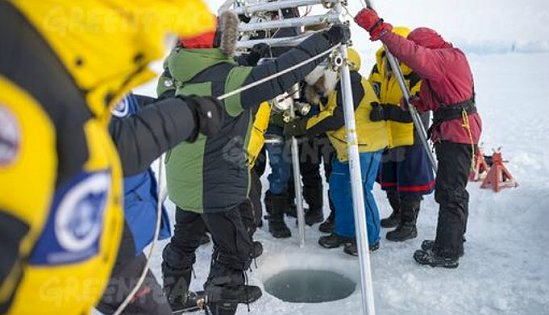|

Flag
for the Future lowered to North Pole seabed. A Greenpeace team
prepare a crane to hoist a time capsule to the seabed at the
North Pole. A “flag for the future” is attached to the glass and
titanium time capsule containing 2.7 million names of supporters
who wish to protect the Arctic. (Photo by Christian Åslund /
Greenpeace) |
Greenpeace plants
symbolic flag on the North Pole seabed to demand that the Arctic be
made a global sanctuary
By GREENPEACE
April 15, 2013
MANILA – Four young people
on a mission with Greenpeace have planted a flag on the seabed beneath
the North Pole, at the same spot where a submarine planted a Russian
flag claiming the Arctic for Moscow. The young people planted their
‘Flag for the Future’ four kilometers beneath the ice at the top of
the world and called for the region to be declared a global sanctuary.
The campaigners held a
ceremony this weekend at the geographic North Pole, led by two Arctic
Indigenous ambassadors. There they cut a hole in the ice and lowered a
flag designed by a child from Malaysia, through the freezing waters to
the seabed.
The flag is attached to a
glass and titanium time capsule containing the signatures of nearly
three million people – including more than 8,000 Filipinos – who asked
for their names to be taken to the Pole when they joined Greenpeace’s
campaign calling for the Arctic to be protected from exploitation.
Many celebrities and prominent leaders, like Nobel Peace Prize winner
Archbishop Desmond Tutu have joined the call for a global sanctuary.
Over the weekend, Archbishop Tutu sent his message to the expedition
team by saying said, "I offer my full support to these young people
who travelled to the North Pole on behalf of those whose lives are
being turned upside down by climate change.”
Hollywood actor Ezra Miller
– star of We Need to Talk About Kevin and The Perks of Being a
Wallflower – is one of the youth ambassadors who planted the flag and
the names. “I can’t feel the tips of my fingers or toes but my head
and heart are filled with a newfound determination. Melting ice is a
catastrophe, not a profit-making opportunity. To see it as such is
utter madness. Three million people have now joined this movement to
declare their commitment to save this vital part of our earth; I feel
honoured to be a part of this team, which was chosen to represent all
of them at this critical moment in history. This is a collective
responsibility. It’s up to all of us, and especially the youth, to
change the way that humanity treats this amazing planet we love and
rely on so completely,” said Miller.
Another youth ambassador is
Renny Bijoux, a member of the Youth Parliament from the island-nation
of Seychelles that is at risk of being submerged by rising sea
levels. “Though we are in the Arctic and I live in the Seychelles, on a
global level it is my homeland too. Whatever happens here affects my
people, from rising seas to growing storms. Sustainable development is
the key. We must respect our environment and develop within its
limits, because if we destroy our climate, we cannot sustain our
development for future generations. The damage is clear and it is
apparent. It’s time for those in power like the Arctic Council to realise this and see that protecting the Arctic is a global
necessity”, said Bijoux.
Like the islands in the
Indian Ocean, countries in Southeast Asia have been cited as some of
the world’s most vulnerable, yet least prepared to cope with the
devastating impacts of climate change.
The 5th Annual Climate
Change and Environmental Risk Atlas (2013), released by global risk
and strategic firm Maplecroft, has identified Manila, Bangkok and
Jakarta under extreme risk from climate change. These cities have seen
major flooding in recent years which can become more frequent or more
severe in the future. Long-term changes in temperature and rainfall
patterns is guaranteed to have devastating effects on ecosystems,
human health, industrial processes, supply chains and infrastructure.
The expedition coincided
with the first ever meeting at the North Pole of the Arctic Council,
the governing body comprised of foreign ministers and senior officials
from Arctic states. As the expedition started, the youth ambassadors
requested for a meeting with the Arctic Council, but were refused. The
weeklong expedition to the Pole is part of a global campaign to
protect the Arctic, under threat from climate change, oil companies,
industrial fishing and shipping. As global warming melts the sea ice,
companies such as Shell, Gazprom and Statoil are moving in to exploit
the region's oil as nation states lay claim to areas previously
covered by ice.
The youth ambassadors and
Greenpeace campaigners have challenged the companies and nations
seeking to profit from climate change. By planting the time capsule
and flag, they have drawn a line in the ice, telling the polluters and
oil companies: you come no further.
The young people are part of
a Greenpeace team that trekked for one week across the frozen ocean in
freezing winds and temperatures of minus 30 degrees Celsius. They
traveled around 10 km a day, each dragging heavy sleighs weighing 80kg
behind them. In a remote and dangerous environment their supplies
dwindled as the shifting ice took them further from the Pole. The team
then hitched a ride with a helicopter that was flying in from the
nearby Barneo Base, to put them within striking distance of the Pole,
allowing them to ski and drift a shorter final distance and complete
their journey to the top of the world.
Even as the Flag for the
Future has already been planted, the fight to save the Arctic
continues. People are invited to sign the Greenpeace petition at
www.savetheartic.org.
Related story:
13 year old Malaysian girl wins Greenpeace’s
Flag for the Future Arctic competition